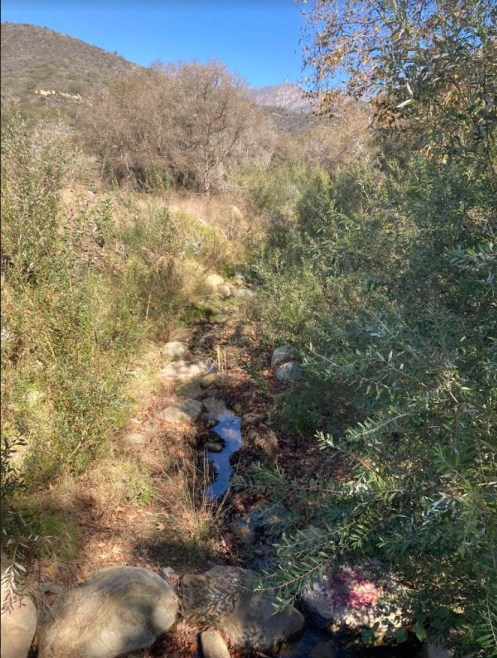Vote No on Cresco
Choose the Creek over Cannabis Cash
Five years ago, after legalized weed, our farm and the surrounding Arroyo Paredon Watershed in Carpinteria became overrun by a single dominant stench: cannabis. Every day, a foul kaleidoscope of skunk, teenage body odor, burning rubber, and indescribable funk drifts across our farm at all hours, sometimes passing by on a breeze and sometimes lingering, thanks to Cresco Labs next door and other nearby Big Cannabis operations.

But the smell is no longer my primary concern. Five years into living in the Cannabis Zone in Carpinteria, I am laser focused on environmental degradation being caused by the pot operations. That’s why I’ve started Save the Arroyo Paredon Watershed, a creek protection and advocacy group.
I am worried about what is happening to the federally endangered steelhead and tidewater gobi in Arroyo Paredon Creek when exposed to cannabis fumes, and aerosol chemicals (odor deodorizers, pesticides, fungicides, and more) 24/7. How does having so much of this new industry so near the creek and ocean change the habitat for the ecologically sensitive plants and animals found there? And what about the ocean animals, subjected to the air and water running off into the Pacific?
To try to understand these problems, I read “A Review of the Effects of Cannabis Cultivation on Fish and Wildlife Resources” by Ange Baker, Senior Resource Scientist for the California Department of Fish and Wildlife.
According to Baker’s report, pot operations degrade the habitat for plants and animals through overactive water resource use, the use of rodenticides, water diversions, site development, and direct ingestion of the plant itself, among many other issues. Baker states that cannabis “…cultivation in sensitive ecosystems means that marijuana cultivation can have environmental impacts that are disproportionately large given the area under production.”
Cresco Labs is a perfect example of this “disproportionately large impact.” Here in our neighborhood, the Michigan-based corporate weed titan plans to erect a new, two-story office building and cannabis processing warehouse (which we know is stinkier than cultivation alone), right on the banks of Arroyo Paredon Creek. They want to have 75 employees parking and working right next to the creek every day, with operations extending 24 hours a day, seven days a week. This new corporate headquarters requires the installation of two new septic tanks, just outside Environmentally Sensitive Habitat, plus two large, new flood control ditches, with massive cut and fill of earth and more.
How could we fix Cresco and Big Cannabis’ slow-motion environmental and public health crisis for Arroyo Paredon Watershed? First off, the Board of Supervisors must vote to reject Cresco Labs’ project, due to its clear threat to the steelhead trout and tidewater gobi living nearby.
As well, to protect the environment from Big Cannabis county-wide, the Board of Supervisors need to adopt the following changes:
(1) Ensure that Cresco (and all pot grows in the Coastal Zone) employ sealed greenhouses with carbon filtration to prevent air pollution.
(2) Rescind the Programmatic Environmental Impact Report and instead require that all weed projects conduct a unique study of how the environment will be impacted by each project and show mitigation measures.
(3) Conduct independent scientific research into the environmental degradation caused by Big Cannabis, funded by the industry itself, as a flat fee levied with each project application.
(4) Create and fund a robust cannabis odor enforcement program.
(5) Hire an independent biologist solely to supervise the development of Big Cannabis projects on the environment.
I urge the county supervisors, and the public, to choose the environment over cannabis cash.




You must be logged in to post a comment.